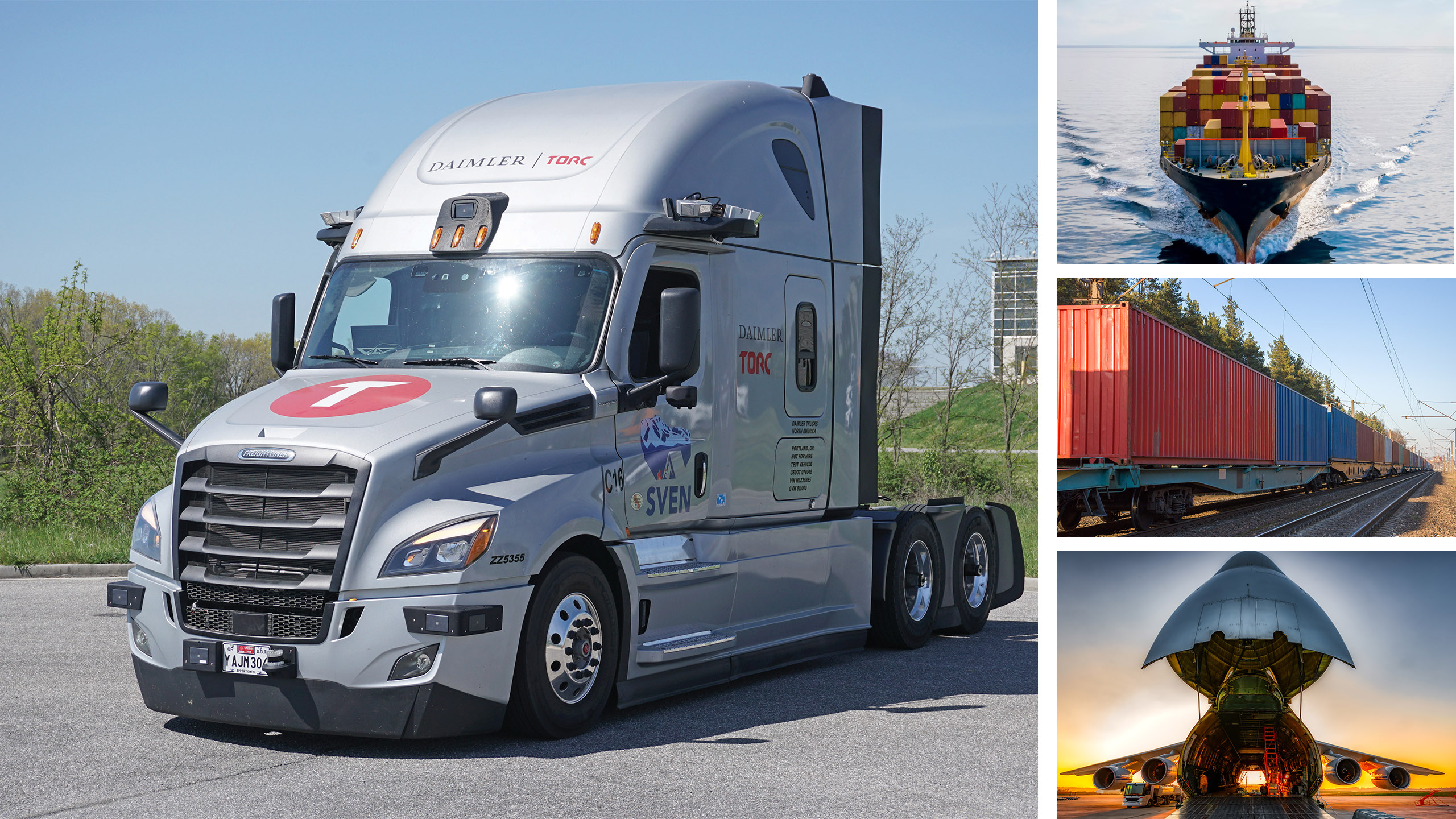In recent years, shipping has exploded in lightning-fast ways. Among the e-commerce crowd, two-day shipping is an expectation, not an extra fee. For those who shop local, we’ve all enjoyed a vast variety of countless products, curbside pickup options, and even store-to-door programs; we’ve even got a real-world look at what our day-to-day looks like when shipping slows down.
As the shipping world continues to develop, we’re taking a deep dive into how it all works and how it might look tomorrow. Together, freight, innovation, and autonomy are creating an incredibly bright future for shipping across the United States.
There are tons of ways to ship something, but we generally organize the transportation of goods into a few categories: road, maritime, rail, and air shipments. Across these industries, autonomy is rapidly changing the conversation: setting the scene for a future that moves faster, safer, and with greater accuracy.
At Torc, we’re always looking forward at the future of freight. From drones to Freightliners, our future features self-driving vehicles that offer endless opportunities.
Road: Autonomous Semi-Trucks
Out of all the existing shipping methods, we all probably have the most up-close-and-personal experience with trucking. On highways, we’ve all driven past 18-wheelers. On road trip rest stops, we’ve probably all parked beside semi-trucks at one point or another. In the long-haul freight world, trucking accounts for 72.5% of the transportation of goods in the United States, including food and medicine. Now, imagine how much more we could move if robots helped us along the way.
Autonomous trucks, like the ones we’re developing here at Torc Robotics, are going to revolutionize the shipping industry in our not-too-distant future. With self-driving cars and vehicles already out on the market, it’s not surprising that autonomous trucks are the next up-and-coming technology to change the world of long-haul.
In a recent study on autonomy completed by the United States Department of Transportation, Level 4 and Level 5 automation of the trucking industry would increase produce welfare from $35 per person to as much as $69 per person. Autonomous vehicle technology will also spark the evolution of the freight industry in employee wellness, future innovation, and more. From creating safer jobs that allow truckers to spend every night at home to inspiring the next great generation of autonomous technology, autonomous trucking is going to simplify supply chains and unearth new opportunities across a variety of industries.
We believe that Torc trucks will be the first commercially successful application of autonomous vehicles on United States roads. At Torc, we’re focused on long–haul transport with the goal of saving lives by reducing road-related fatalities, diminishing the impact of the worker gap in the long–haul trucking industry and creating a better tomorrow.
Maritime: Autonomous Cargo Ships
Right now, cargo ships are the most cost-effective and emissions-efficient means of transporting goods. As technologies have advanced, so has maritime shipping. Where once we used manpower and simple machines to move heavy loads, cargo vessels now can benefit from computer-controlled cranes. At inspection time, inspectors can carry out their responsibilities more safely via the use of drones – even if inspections need to be carried out under the water.
Autonomy has been transforming the maritime landscape for some time, but the future brings a host of new opportunities. Remote-controlled ships, self-driving ships, artificial intelligence-led voyages, and more, are on the horizon, allowing goods to move faster than ever. Worldwide, there are more than 1,000 maritime autonomous vehicles running today. These vessels are partially autonomous, meaning that while algorithms and sensors carry the ship for a good part of the way, there are still some responsibilities and duties that require a human crew to take care of.
Like autonomous trucks, remote-controlled ships use a combination of lidar, cameras, and other sensors to learn about the surrounding environment. While self-sailing voyages are largely led by long–haul cargo ships, countless innovators are looking towards autonomous vessels that can run ferry operations, household waste removal, and more.
Rail: Autonomous Freight Trains
Runaway trains, meet the autonomous freight train. The train industry is one of the United States’ oldest contenders. Our existing train railways are, in fact, a fantastic idea of what the autonomous truck’s future might look like soon, at least as far as infrastructure goes: vehicles run from hub-to-hub or station-to-station, wherein a human crew assists in loading and unloading cargo before the next journey.
Although moving freight by rail has been mostly stagnant for the past few decades, the near future brings a host of out-of-the-box thinking forward. Driverless trains for freight loads are on the horizon, adding artificial intelligence to one of the United States’ oldest industries. In the great freight race, this is another area that is ready for an autonomous future.
Air: Automated Airplanes
Out of all the autonomous ways to transport goods, airplanes are probably the easiest one to get your head wrapped around. After all, existing airplanes are, in many ways, largely autonomous. Today, pilots are supplemented with autopilot functions that allow planes to fly on their own once they’re up in the air. Pilots handle take-off, landing, and any unexpected circumstances that may arise while inflight.
When it comes to freight-laden planes, several companies across the freight landscape are developing software that can take-off and land all on its own, adding a layer of safety to cargo flights altogether.
We’d be remiss to not mention drones in this category, too. Autonomous cargo delivery via drone once seemed like the stuff of science-fiction when it comes to self-driving vehicles, but it’s rapidly becoming a reality across many companies, software developments, and more.
The Autonomous Future
In our grand self-driving future, we can’t wait to see what comes next. At Torc Robotics, we’re leading the charge towards autonomous trucking in an effort to reach that future with safe, sustainable outcomes. We cheer on our freight industry colleagues in the pursuit of a safer, faster, and more efficient shipping future.

